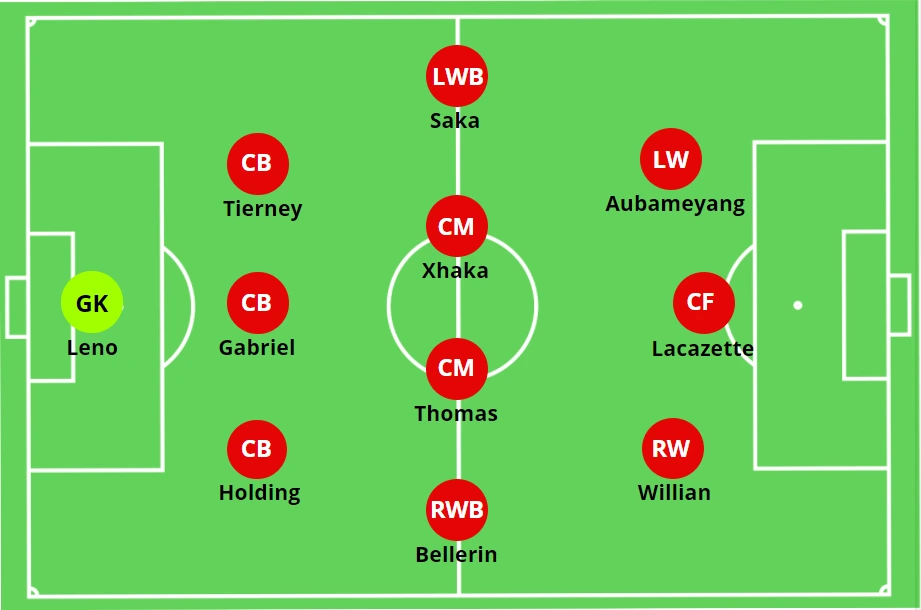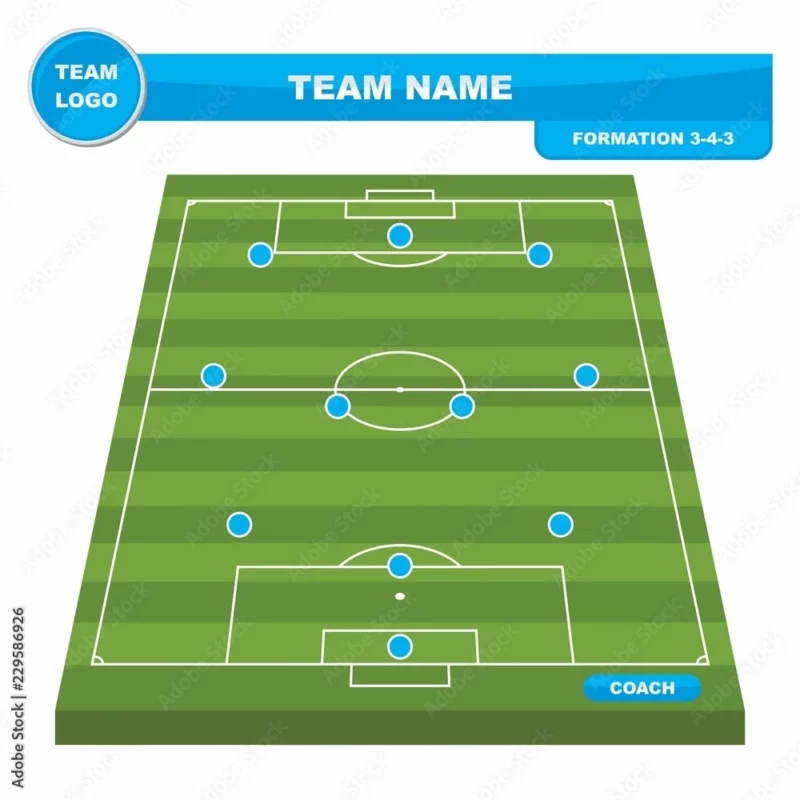Are you ready to revolutionize your soccer tactics and take your team’s performance to the next level? Look no further than the dynamic and electrifying 3-4-3 formation! In this blog post, we will dive deep into the intricacies of this game-changing strategy, dissecting its strengths, weaknesses, and everything in between.
Introduction to the 3-4-3 formation
The 3-4-3 formation, also known as the “three at the back” formation, is a popular and versatile tactical system used in modern football. It involves three defenders, four midfielders, and three forwards, making it an attacking-minded formation. This formation has gained popularity in recent years due to its ability to provide balance between defense and attack.
1. History of the 3-4-3 Formation
The 3-4-3 formation originated in South America during the 1970s but was later made famous by Dutch manager Rinus Michels during his time with Barcelona in the late 1980s. The formation gained widespread recognition when Johan Cruyff implemented it at Barcelona during his tenure as manager in the early 1990s. Since then, many top clubs around the world have adopted this formation with great success.
2. Formation Overview
In this system, there are three central defenders who are responsible for protecting their own goal from opposition attacks. These defenders are supported by two wing-backs who play a crucial role in both defending and attacking. The wing-backs have dual responsibilities of tracking back to help out defensively and pushing forward to provide width on the attack.
Moving upfield, there are four players deployed in midfield – two central midfielders and two wide midfielders. The central midfielders act as a link between defense and attack while also providing cover for their teammates when needed. The wide midfielders have the freedom to move up and down the flanks, providing support to both the defense and attack.

At the top of the formation, there are three forwards – a center forward and two wide forwards. The center forward is typically a traditional number 9 striker who is responsible for scoring goals, holding up play, and creating chances for his teammates. The wide forwards, also known as inside forwards, are versatile attackers who can drift into central areas to create goal-scoring opportunities.
Advantages and disadvantages of using the 3-4-3 formation
Like any other formation, the 3-4-3 has its own set of advantages and disadvantages that coaches and players should consider before implementing it on the field.
Advantages
1. Attacking potential
The 3-4-3 formation is known for its attacking prowess. With three forwards constantly pushing forward, this formation puts immense pressure on the opposition’s defense. The two wingers provide width, while the central striker acts as a target man to receive crosses or through balls from the midfield.
2. Fluidity
This formation allows for fluid movement between players as they can switch positions quickly during attacks. The midfielders have the freedom to push up and join the attack while also providing cover for the defenders when needed. This fluidity can create confusion for opponents who are trying to mark specific players.
3. Overlapping full-backs
The use of wing-backs in this formation provides an extra layer of attack as they have more space to run into due to the presence of only three defenders. This allows them to overlap with their wingers and whip in crosses or cut inside and take shots on goal.
4. Pressing high up the pitch
With four midfielders operating in front of a backline of three, this formation allows teams to press high up the pitch and win back possession quickly. The forward line can also contribute to this pressing, making it difficult for the opposition to build attacks from the back.
Disadvantages

1. Vulnerable defense
The 3-4-3 formation leaves only three defenders at the back, making it vulnerable to counter-attacks and long balls over the top. If the opposition can bypass the midfield and get behind the defense, they can create scoring opportunities with just one or two attackers.
2. Lack of defensive cover
With only four midfielders, there is a risk of being outnumbered in central areas if the opposition plays with a diamond or narrow midfield setup. This can leave gaps in front of the backline, making it easier for opponents to find space and create chances.
3. Requires technically gifted players
This formation relies heavily on player movement and interchangeability, so it requires technically gifted players who are comfortable with playing in multiple positions. If a team doesn’t have such players, they may struggle to execute this formation effectively.
4. Tiring for wing-backs
The wing-backs in this formation have to cover large distances throughout the game as they are expected to contribute both offensively and defensively. This can be physically demanding and may lead to fatigue as the game progresses, especially if there are no suitable substitutes available.
Famous teams and managers who have successfully used the 3-4-3 formation
The 3-4-3 formation has gained popularity in recent years due to its attacking nature and versatility. Many famous teams and managers have successfully utilized this formation to achieve great success on the field. In this section, we will take a closer look at some of these notable teams and managers who have made the 3-4-3 formation their own.
1. Chelsea FC (Antonio Conte)
One of the most well-known teams to adopt the 3-4-3 formation is Chelsea FC under the management of Antonio Conte.
Conte introduced a successful formation in his first season in 2016/2017 as manager, leading the club to their fifth Premier League title with 30 wins out of 38 games. The key to their success was their solid defensive structure with three center-backs, while also maintaining a strong attacking presence with three forwards. This allowed for quick transitions from defense to attack and caught many opponents off guard.
2. FC Barcelona (Pep Guardiola)
Known for his innovative tactics and formations, Pep Guardiola used the 3-4-3 system during his tenure as manager of FC Barcelona from 2008 to 2012.
With a star-studded squad consisting of Lionel Messi, Xavi Hernandez, Andres Iniesta and others, Guardiola’s Barca dominated both domestically and in Europe using this formation. The fluid movement between midfielders and forwards created confusion for opposing defenses, making them one of the most feared teams in world football.

3. Juventus FC (Max Allegri)
Another successful Italian manager who has utilized the 3-4-3 formation is Max Allegri at Juventus FC.
During his time at the club from 2014 to 2019, Allegri’s Juventus won five consecutive Serie A titles and reached two Champions League finals using this system. The three-man defense provided a strong defensive foundation, while the wing-backs offered width and support in attack. This allowed for the team to control possession and create numerous scoring opportunities.
4. Manchester City FC (Pep Guardiola)
After his success at Barcelona, Pep Guardiola brought his 3-4-3 formation to Manchester City FC in 2016.
With a strong focus on possession and fluid attacking movements, Guardiola’s City won back-to-back Premier League titles in 2018 and 2019. The team’s talented attackers such as Kevin De Bruyne, Sergio Agüero, and Raheem Sterling thrived in this system, which allowed them to score goals at an impressive rate.
Conclusion
The 3-4-3 formation may not be as popular as some other formations in modern soccer, but it offers a unique and effective way to play the game. A soccer formation with 3 defenders, 4 midfielders, and 3 strikers allows for flexibility and creativity on both offense and defense. By utilizing these tips and tactics, teams can maximize their potential with this dynamic formation.
FAQs
That depends on the team’s playing style and strengths. 3-4-3 is an attacking formation that allows for more players to join the attack, however, it also leaves fewer defenders at the back. If your team has strong attacking players and a solid defense, 3-4-3 could be a good option.
It all depends on the team’s strategy and players’ abilities to execute it effectively. In fact, many successful teams have used this formation in their games with great success. At the end of the day, it’s not about the formation but how well the team works together and utilizes their strengths on the field.
The presence of skilled central defenders who can play the ball well is crucial in countering a 4-3-3 formation.





